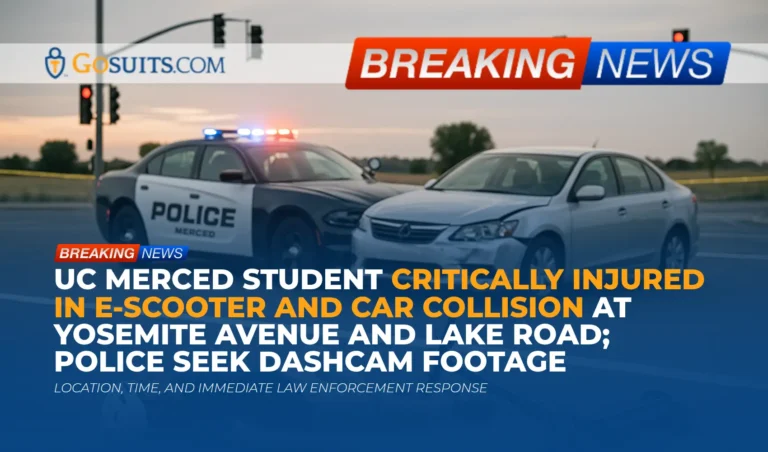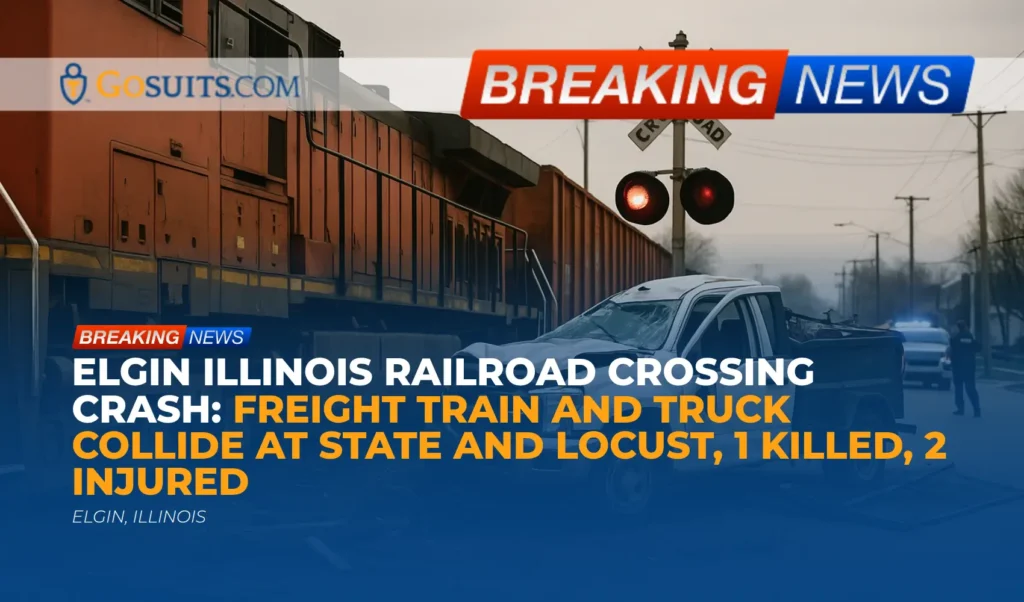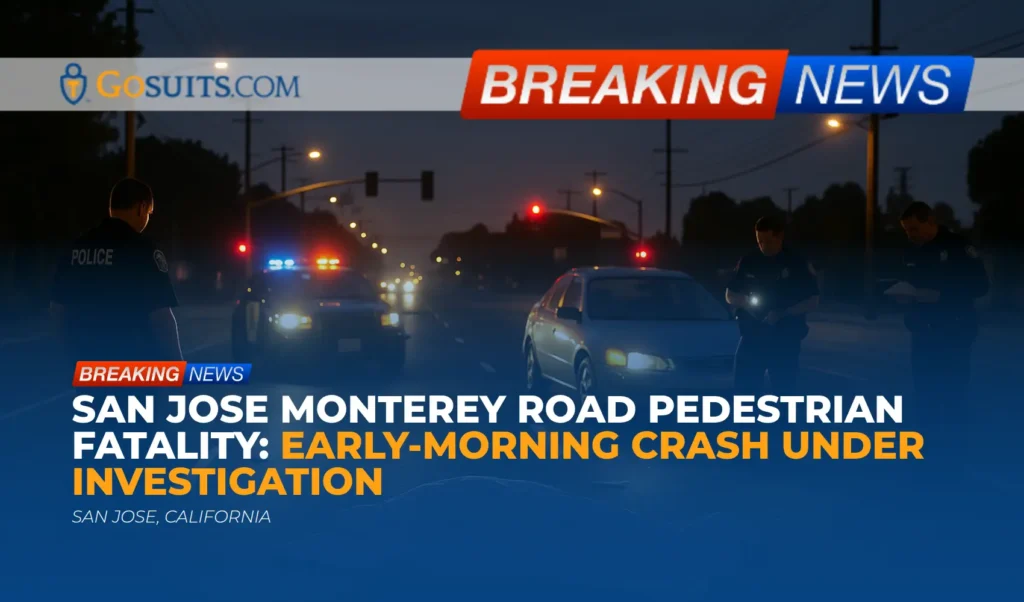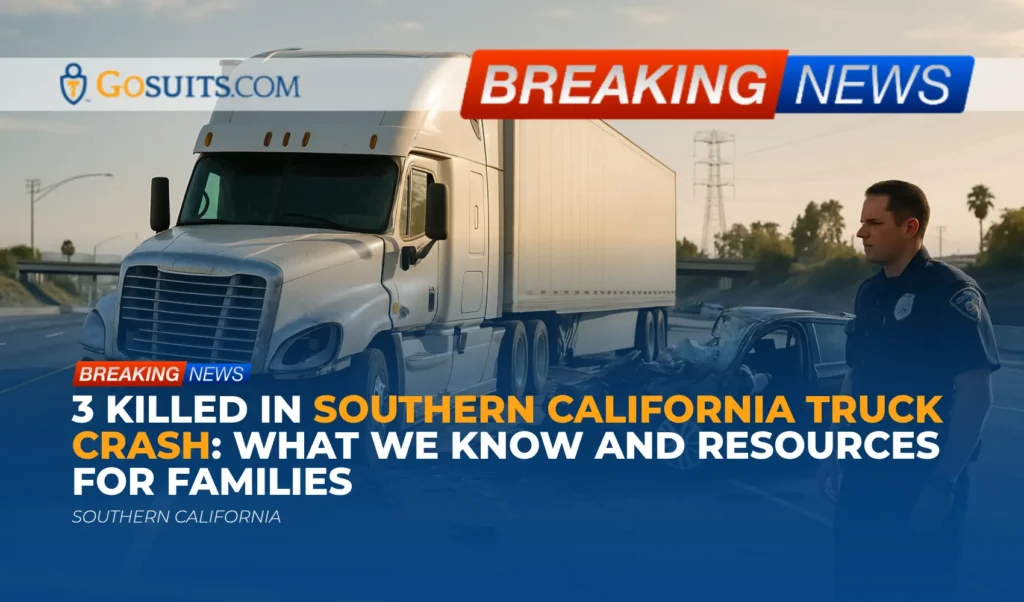- Incident overview and known facts
- Location, time, and immediate law enforcement response
- What investigators may examine and why it matters
- California rules for e-scooters, bikes, helmets, and lighting
- Safety context and injury risks for e-scooter riders
- Rights after a traffic collision in California
- Where to get official information and help in Merced County
- Practical steps to take after a serious e-scooter vs. car collision
- Potential civil liability considerations
- Intersections: data and safety trends
- How families can support an injured student patient
- Call-to-action: Why acting promptly matters
- Commentary from Gosuits Merced, California Personal Injury Attorney
Incident overview and known facts
According to local reporting, an 18-year-old UC Merced student from Los Angeles was struck by a car while riding an e-scooter in Merced and was hospitalized in critical condition. The collision occurred around 5:30 p.m. near the intersection of Yosemite Avenue and Lake Road, not far from the UC Merced campus. Responding officers indicated they were collecting roadway evidence, marking the scene, and downloading information and data from the vehicle involved to measure speeds. Investigators asked the public for any dashcam or other video that might help determine which traffic signal had the right of way at the time of impact. Officers also noted that many e-bikes and e-scooters have limited lighting and advised riders to add lights and wear helmets, emphasizing extra caution on the road.
This article summarizes what is publicly known, explains the typical investigative process after a serious traffic collision, and outlines practical next steps and resources. It also discusses relevant California rules that may affect liability and safety, with compassion for the student, family, and campus community coping with a sudden, traumatic event.
Location, time, and immediate law enforcement response
The collision location—Yosemite Avenue and Lake Road—sits near UC Merced and is commonly used by students and local residents. The time reported, approximately 5:30 p.m., may coincide with heavier evening traffic and changing daylight depending on the season. In many serious crashes, officers document physical evidence such as skid or yaw marks, scrape paths, debris fields, vehicle rest positions, and signal light status. They may also request data from involved vehicles and seek independent recordings from nearby businesses, residences, transit vehicles, and private motorists.
Here, law enforcement requested dashcam or other video footage to help determine which party had the green signal. Establishing right of way at a signalized intersection is often a central question in both the police investigation and later civil liability analysis.
What investigators may examine and why it matters
Traffic signals, timing, and right of way
At signalized intersections, investigators evaluate:
- Signal phase at time of impact such as green, yellow, or red for each approach, often supported by witness accounts and available video. In some jurisdictions, traffic engineering departments can provide signal timing charts or phase and timing logs. Requests for public records in California can be made under the California Public Records Act, which is described by the California Attorney General’s Office at oag.ca.gov.
- Yellow interval and clearance times that may factor into whether either party entered on a stale yellow or against a red.
- Visibility factors such as sun angle, glare, roadside vegetation, or obstructions, all of which can affect driver and rider perception at dusk.
Vehicle data and roadway evidence
Officers noted “feeding information and data from the vehicle involved to determine speeds.” Many modern vehicles contain event data recorders (EDRs), which may capture pre-crash speed, braking, throttle input, and seatbelt status. The National Highway Traffic Safety Administration provides information about EDRs at nhtsa.gov/equipment/event-data-recorders-edrs. While the data available varies by make and model, these records, when available and lawfully obtained, can corroborate or contradict witness accounts.
Beyond electronic data, investigators typically document:
- Tire marks and gouges showing pre-impact braking, steering, or loss of control.
- Impact points and crush profiles on vehicles or scooters to help reconstruct angles and speeds.
- Lighting conditions and whether any lights on the scooter or vehicle were functioning.
Visibility and lighting for e-scooters
Police pointed out that many e-scooters and e-bikes have limited factory lighting. Under California law, certain lighting is required at night. Riders who add brighter front lights and rear lights or reflectors can markedly improve conspicuity at dusk and after dark. The Federal Highway Administration emphasizes the safety challenges at intersections and the importance of visibility measures at safety.fhwa.dot.gov/intersection/.
California rules for e-scooters, bikes, helmets, and lighting
Several sections of the California Vehicle Code (CVC) define equipment and operation rules for bicycles, e-bikes, and motorized scooters. The official text of the CVC is available via California’s Legislative Information portal at leginfo.legislature.ca.gov/faces/codes.xhtml. Key provisions include:
- Lighting and reflectors
- Bicycles: CVC 21201 generally requires, when riding at night, a white front lamp visible from at least 300 feet, a red rear reflector, pedal or ankle reflectors, and side reflectors on the front and rear of the bicycle.
- Motorized scooters: CVC 21223 outlines required equipment for night operation, which typically includes a white front lamp visible from 300 feet and required reflectors. Some requirements may be satisfied by equipment worn by the rider.
- Helmet rules
- Bicycles and non-Class 3 e-bikes: CVC 21212 requires riders under 18 to wear a properly fitted, fastened helmet while riding on a bicycle, nonmotorized scooter, or similar device.
- Motorized scooters: CVC 21235 requires riders under 18 to wear a helmet on a motorized scooter.
- Class 3 e-bikes: CVC 21213 addresses Class 3 e-bikes, including minimum operator age and helmet requirements.
- Operating location and right of way
- California law addresses where scooters and bicycles may be ridden, their duties at traffic signals and stop signs, and expectations to follow the rules of the road similar to other vehicle operators.
These rules matter in a civil case because they can affect determinations of negligence and comparative fault. However, even if a rider did not meet every equipment requirement, liability still turns on the totality of circumstances: which party had the right of way, whether the driver kept a proper lookout, speed relative to conditions, and other factors. California’s comparative fault framework assigns percentages of responsibility among involved parties based on evidence. The California Courts’ Self-Help Center provides general civil case information at courts.ca.gov/selfhelp.htm.
Safety context and injury risks for e-scooter riders
E-scooters are small, fast, and quiet, and they can be difficult for drivers to detect, particularly in low light or complex intersections. National and public health agencies have highlighted elevated risks of head injury among micromobility riders and low helmet usage rates. The Centers for Disease Control and Prevention has published research on e-scooter injury patterns, noting that head injuries are common and that helmet use is often rare in observed cohorts. For broader injury prevention resources, visit the CDC’s National Center for Injury Prevention and Control at cdc.gov/injury/.
From a traffic systems perspective, intersections remain high-conflict areas for vulnerable road users. The Federal Highway Administration’s intersection safety resources at safety.fhwa.dot.gov/intersection/ discuss strategies to improve visibility, manage speeds, and reduce conflicts for pedestrians, cyclists, and scooter riders. While infrastructure changes are longer-term, near-term steps like high-visibility lighting, reflective wear, and rider positioning can help drivers see riders sooner.
Rights after a traffic collision in California
Accessing police collision reports
In California, the collision report is typically maintained by the responding agency. Within city limits, that is often the city police department; on state highways, it may be the California Highway Patrol (CHP). The CHP explains the process for requesting a collision report at chp.ca.gov/traffic-operations-section/site-page/request-a-collision-report. Requesters should be prepared to provide the report number, date, and location.
Members of the public may request government records under the California Public Records Act. The Attorney General provides information about public records requests and transparency at oag.ca.gov. Some records related to active investigations may be delayed or partially redacted under applicable exemptions.
Submitting dashcam or surveillance video to police
When investigators request the public’s assistance, timely submission of dashcam or security footage can be pivotal. Video with accurate timestamps showing the signal cycle, vehicle positions, and lighting conditions can help reconstruct events. UC Merced community members who believe a campus camera may have captured relevant footage can coordinate with the UC Merced Police Department at police.ucmerced.edu to understand the preservation and request process for campus-held video.
Preserving personal evidence
It is important to preserve the scooter, helmet, clothing, and any accessories (mountable lights, reflectors) in the condition they were in after the crash. Photographs of injuries and property damage, as well as contemporaneous notes about pain, medical appointments, and missed school or work, can document losses for insurance claims.

Insurance considerations
When a motor vehicle strikes a scooter rider, the at-fault driver’s auto liability insurance often becomes central to the claim. If fault is disputed, evidence such as signal timing, video, and EDR data may help resolve liability. In some cases, a rider’s own health insurance or medical payments coverage on a household auto policy may help with immediate medical costs, depending on policy terms. If the driver is uninsured or underinsured, certain coverages can be important, but their applicability depends on the facts and the policy language.
Before making any statement to an insurance company, it is generally advisable to consult with a lawyer to understand legal rights and the potential impact of recorded statements. Statements made to insurers can be used to contest fault or minimize compensation later.
Where to get official information and help in Merced County
Different agencies may hold different records or be able to answer distinct questions following a serious collision. Some common points of contact include:
- Investigating police department records unit: The investigating agency’s records division maintains the official collision report. Request procedures usually require a report number, names or vehicle plates, and a signed request form. For crashes on state routes, see CHP’s collision report request page at chp.ca.gov/traffic-operations-section/site-page/request-a-collision-report.
- UC Merced Police Department: For questions about potential campus surveillance footage or campus safety coordination, see police.ucmerced.edu.
- Traffic engineering/public works: Signal timing records, if available and disclosable, are generally managed by a city or county traffic engineering office. Requests are typically made under the California Public Records Act. Guidance on public records rights is available from the Attorney General at oag.ca.gov.
- Hospitals and medical providers: Medical records can be requested directly from the treating hospital or clinic. Federal privacy rules outlining patient rights to access medical records are summarized by the U.S. Department of Health and Human Services at hhs.gov/hipaa/for-individuals/index.html.
- Coroner’s office (in fatal cases): If a collision results in a fatality, the county sheriff-coroner typically manages postmortem examinations and reports. Procedures and timelines vary by county. For general California vital records information, see the California Department of Public Health at cdph.ca.gov.
- Statewide traffic safety data: For context on collision trends and safety initiatives, the California Office of Traffic Safety provides statewide resources at ots.ca.gov.
If uncertain which agency has a specific record, asking the responding officer at the scene (when appropriate) or contacting the non-emergency line of the local police department can help clarify the correct point of contact.
Practical steps to take after a serious e-scooter vs. car collision
In the aftermath of a severe crash, it helps to balance immediate care needs with careful documentation. While every situation is unique, the following steps are commonly useful:
- Seek and follow medical care: Prompt evaluation can identify internal injuries or concussions that may not be obvious at first. Keep copies of discharge summaries, imaging, prescriptions, and referrals.
- Preserve the scooter and gear: Store the scooter, helmet, lights, and clothing in a safe place without altering them. Avoid repairs or disposal until the claim resolves or an inspection occurs.
- Secure video evidence: Save dashcam files, home or business surveillance clips, and smartphone videos. Back up copies and note accurate timestamps. Provide relevant footage to investigators upon request.
- Collect scene information: Document the exact location, lane positions, traffic signal locations, weather, and lighting. Note any construction, detours, or blocked sight lines.
- Identify witnesses: Names, contact information, and a brief note of what each witness observed can make a difference if recollections fade.
- Request the police report: Follow the investigating agency’s process to obtain the report once available. See CHP’s general guidance at chp.ca.gov/traffic-operations-section/site-page/request-a-collision-report.
- Document the impact on daily life: Keep a simple journal of pain levels, mobility challenges, school attendance, sleep, and emotional well-being; track out-of-pocket costs, transportation expenses, and caregiving needs.
- Consult an attorney before speaking with insurers: Before giving a recorded statement or accepting any settlement offer, consider talking with a lawyer to understand rights and potential pitfalls. What is said to an insurance company can be used later to dispute fault or reduce claimed losses.
Potential civil liability considerations
Driver negligence and comparative fault
Civil liability usually centers on whether a party failed to use reasonable care under the circumstances. Examples can include entering an intersection against a red signal, failing to yield, traveling too fast for conditions, or not maintaining a proper lookout. California applies a comparative fault framework, meaning responsibility can be allocated among multiple parties. Evidence about signal phasing, video footage, vehicle data, and roadway markings often helps resolve disputed accounts. The California Courts’ Self-Help Center provides basic information about civil cases at courts.ca.gov/selfhelp.htm.
Equipment, visibility, and roadway conditions
Lighting and reflectors on scooters can matter both for safety and in fault apportionment, particularly at dusk or night. However, even with limited lighting, drivers must still use due care appropriate for conditions. Roadway environment can also be relevant: missing signage, malfunctioning signals, or obstructed views may play a role. If a claim involves allegations against a public entity over roadway design or maintenance, special claim procedures and shorter deadlines may apply under California law. The California Courts’ Self-Help resources include guidance on claims against government entities at courts.ca.gov/selfhelp.htm.
Timing considerations
Time limits apply to civil claims, and claims involving public entities can have shorter deadlines than standard personal injury claims. Because deadlines vary and facts matter, individuals often consult with counsel early to avoid missing a filing date. The California Legislative Information site provides primary law resources at leginfo.legislature.ca.gov/faces/codes.xhtml.
Intersections: data and safety trends
Intersections concentrate conflict points for turning, crossing, and merging traffic. The U.S. Federal Highway Administration highlights that a significant share of serious crashes occur at or near intersections and promotes countermeasures such as improved signal visibility, protected turn phases, and speed management to reduce crash severity. See FHWA’s overview at safety.fhwa.dot.gov/intersection/.
For California-specific collision data and safety priorities, the Office of Traffic Safety shares statewide and local trend information at ots.ca.gov. These resources help communities and policymakers understand where risks are concentrated and which engineering or enforcement strategies may be most effective. Though data can’t change what has happened, it can inform safer street designs and awareness efforts around campuses and student-heavy corridors like Yosemite Avenue and Lake Road.
How families can support an injured student patient
When a young person is critically injured, families and loved ones often balance overwhelming emotions with practical responsibilities. Hospitals typically allow a designated point person to communicate with the care team and receive updates. The U.S. Department of Health and Human Services explains patient health information rights under HIPAA at hhs.gov/hipaa/for-individuals/index.html. Families can ask about:
- Care coordination: Who is the attending physician? What specialists are involved? What is the plan for the next 24 to 72 hours?
- Rehabilitation needs: Whether physical therapy, occupational therapy, neurocognitive evaluation, or social work support will be part of the plan.
- Discharge planning: Medications, follow-up appointments, and transportation or mobility assistance when the patient leaves the hospital.
- Documentation: How to request the medical records needed for school accommodations or insurance claims, and the expected timeline to receive them.
Universities often maintain student support services, including disability accommodations, academic advising, and counseling. UC Merced community members can explore campus safety and police resources at police.ucmerced.edu and consult their student services offices for academic support during recovery.

Call-to-action: Why acting promptly matters
After a severe traffic collision, time-sensitive steps can preserve rights and improve the clarity of the factual record:
- Evidence can disappear quickly: Tire marks fade, debris is cleared, and surveillance systems overwrite older footage. Reaching out to potential video sources and preserving damaged equipment early helps maintain crucial proof.
- Witness memories fade: The sooner witnesses are identified and their recollections documented, the more reliable those accounts tend to be.
- Medical documentation is foundational: Early, thorough medical evaluation connects injuries to the crash, sets a treatment plan, and reduces gaps that insurers may later question.
- Deadlines can be short: Some claims must be initiated within months, not years, especially if a public entity may be involved in any way. Timely action avoids preventable procedural obstacles.
- Insurance communications carry risk: Recorded statements and forms can affect claim outcomes. Understanding rights before speaking to insurers can prevent unintentional misstatements from being used to dispute fault or minimize losses.
In general, acting methodically and without delay helps protect health, preserve evidence, and keep all options open while the facts are investigated.
Commentary from Gosuits Merced, California Personal Injury Attorney
Our hearts are with the injured UC Merced student, their loved ones, and the campus community. A collision of this magnitude is frightening and disorienting, and it is understandable to feel overwhelmed while waiting for updates. The information here is meant for general education to help community members understand what investigators are looking for and which practical steps can safeguard important rights.
From a civil-injury perspective, several details highlighted by officers already stand out: the significance of signal right of way, the request for independent video, and the plan to analyze vehicle data and roadway evidence. At a signalized intersection, those data points often determine the sequence of events. Visibility near dusk and the real-world limitations of stock scooter lighting are also part of the picture. Even so, drivers must adjust for conditions and maintain a proper lookout; small, quiet road users like scooter riders are particularly vulnerable at intersections. Thorough, careful investigation is essential before reaching any conclusions about responsibility.
Insurance carriers and large entities often move quickly after a serious collision. Adjusters can appear helpful while gathering statements, signed authorizations, or early releases that may not serve the injured person’s interests. Corporations may have teams trained to minimize payouts by framing fault in their favor, emphasizing uncertainty, or highlighting equipment issues that only tell part of the story. Without guidance, it is easy to underestimate long-term medical needs, the scope of functional limitations, or the full impact on education and daily life.
Early, no-cost consultations give people a chance to understand their rights, typical timelines, and the types of evidence that matter most. Speaking with a seasoned attorney before engaging with insurance companies can help prevent missteps, ensure key items are preserved, and provide clarity at a time when clear information is hard to come by. While no article can cover every nuance, informed, timely decisions and steady advocacy can make a meaningful difference during recovery and resolution.
References and resources
Primary sources and public resources mentioned above include:
- California Legislative Information: California Vehicle Code and other statutes — leginfo.legislature.ca.gov/faces/codes.xhtml
- California Highway Patrol: Request a collision report — chp.ca.gov/traffic-operations-section/site-page/request-a-collision-report
- California Office of the Attorney General: Public records information — oag.ca.gov
- California Courts: Self-Help Center — courts.ca.gov/selfhelp.htm
- UC Merced Police Department — police.ucmerced.edu
- U.S. Department of Health and Human Services: HIPAA individual rights — hhs.gov/hipaa/for-individuals/index.html
- Federal Highway Administration: Intersection safety — safety.fhwa.dot.gov/intersection/
- NHTSA: Event Data Recorders (EDRs) — nhtsa.gov/equipment/event-data-recorders-edrs
- California Office of Traffic Safety — ots.ca.gov
- California Department of Public Health — cdph.ca.gov






